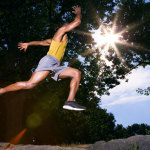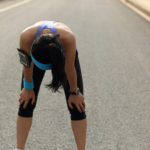What is The Core?
To the rehabilitation world the core is the lumbar-pelvic (trunk) and hip complex. The Core is composed of as many as 35 different muscle groups connecting into the pelvis from the spine and hip area. In order to simplify the Core muscles I have divided them into four regions; back extensors, abdominals, lateral trunk muscles, and the hip muscles.
The core is the center of gravity and where all movement begins. It is also the center of stability for the lower limb, from the foot to the hip. In order for muscles to move bone other muscles need to hold on to bones creating a solid base. Therefore, the muscles in the core function as stabilizers and/or mobilize bone to allow movement. How do the muscles know what to do stabilize or mobilize? The muscle is told what to do by the brain. All we have to do is think go… and the brain sends a message to the muscles that are needed for the activity, e.g. Sprint to the left, slide to the right, or jump. Sometimes the muscles are injured or fatigued or out of shape and then, automatically, other muscles take over to help out. This is when we get injured, pull a muscle, or suffer a high ankle sprain.
The core is an important part of any sport that involves running, jumping, and sprinting. Good muscle strength within the core is very important to golfers, tennis players, baseball players, core muscle strength, endurance, and power is important to any athlete.
In tennis if we attempt to get to a ball that our opponent hits to the other side of the court we need to move laterally and land on one leg while at the same time hit a passing shot down the line. While balancing on one leg we need a stable base to hit off of. If the strength of certain muscle groups in the pelvis and hip are not strong enough our pelvis becomes unstable. Have you ever tried to hit a tennis ball while standing on a wobble board? You will make all sorts of adjustments in order to hit the ball accurately. Those adjustments could develop into an injury or poor technique. Andy Roddick’s coach told me as we improved the strengthened Andy’s pelvis and hip muscles he was able to hit his passing backhand shot more effectively.
In golf strength of the core is critical for driving the ball long and accurate distances. In fact prevention of injuries and improved performance in golf has been directly related to the strength of several hip muscles.
Many individuals work on strengthening of the leg muscles. Many of the professional football players that I have rehabilitated have huge thigh and calf muscles. However, when I start testing their core muscles of the spine and pelvis they fail miserably. The body’s stabilization system has to be functioning optimally to effectively utilize the strength, power, and muscular endurance that they have developed in the prime movers of the lower leg. When a muscle groups are working to stabilize bone their activity is referred to as co-contraction. In other words several muscle groups are firing simultaneously in order to stabilize the joint or joints they surround. Muscle groups are also referred to as agonist and antagonists. That means that they work in pairs. For example the hamstrings and quadriceps muscles (posterior and anterior thigh muscles) work together, as one is slowing down the knee the other is accelerate the knee. The abdominal muscles are important core muscles. However, if they are strengthened without training the muscles of the lumbar spine (the antagonists), or the lateral muscles of the trunk, the athlete is might develop tightness or instability in the low back area, which will have a significant impact on they performance and increase the chance of injury. When one muscle group becomes too strong and the antagonist becomes weakened it is referred to as a muscle imbalance. Muscle imbalances are a major cause of injures in athletes.
How can we know if we have weakness of the Core muscles?
I have put together an evaluation of specific tests to determine muscle strength of the core muscles. One of the tests I use is a simple single leg stance position. It is amazing how many athletes have difficulty standing on one leg for 6 seconds. Then I ask the athlete to do a partial squat while attempting to maintain their knee over the foot. Many times I observe no control of the leg. As the athlete performs a partial squat they start to loss their balance or are unable to maintain their knee over their foot, as the knee moves from side to side during the squat. I have observed many athletes with low back pain, hip pain, and knee pain and patellofemoral pain syndrome as a result of weakness of the core muscles. The lack of strength of these stabilizers can cause chronic injury or poor performance on the tennis court.
What can we do to strengthen the Core muscles?
There are many exercises that I prescribe to my patients for core strengthening. The exercises include basic weight lifting to strengthen the hip muscles to isometric exercises for the back extensors, abdominals, and lateral trunk muscle.
A strong and stable core can improve optimal performance throughout the lower leg and enable the athlete greater speed and endurance which will improve performance and prevent injuries.





